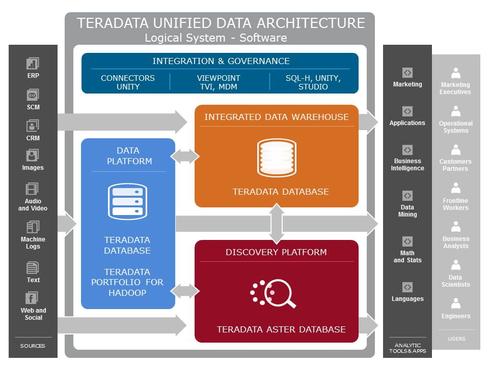
Teradata delivers unified big data architecture
Analytical DBMS: Teradata, Teradata Aster.
In-memory DBMS: Although not an in-memory DBMS, Teradata Intelligent Memory monitors queries and automatically moves the most-requested data to the fastest storage tiers available, with options including RAM, flash, SSD, and various speeds of conventional spinning discs.
Stream-analysis option: None.
Hadoop distribution: Resells and supports the Hortonworks Data Platform.
Hardware/software systems: Teradata and Teradata Aster are integrated software/hardware systems. Hadoop is supported with two Teradata appliance offerings as well as standardized Dell configurations.
Analytical DBMS: Teradata, Teradata Aster.
In-memory DBMS: Although not an in-memory DBMS, Teradata Intelligent Memory monitors queries and automatically moves the most-requested data to the fastest storage tiers available, with options including RAM, flash, SSD, and various speeds of conventional spinning discs.
Stream-analysis option: None.
Hadoop distribution: Resells and supports the Hortonworks Data Platform.
Hardware/software systems: Teradata and Teradata Aster are integrated software/hardware systems. Hadoop is supported with two Teradata appliance offerings as well as standardized Dell configurations.
Teradata entered the big-data era boasting the largest roster of petabyte-scale enterprise data warehouse (EDW) customers of any vendor. It took a couple of years for the company to accept that SQL could not satisfy all needs, but in 2011 it acquired Aster Data and in 2012 it partnered with Hortonworks to build out what it calls its Unified Data Architecture (UDA).
The Teradata DBMS is at the heart of the UDA, supporting EDWs and marts for production BI and analytical needs. Options include SQL and various in-database analytic options including extensive support for SAS. The company has kept this DBMS at the forefront of performance with hybrid row and columnar compression and an Intelligent Memory feature for fast querying from RAM as well as SSDs, flash, or various speeds of spinning disks.
Aster is the UDA data-discovery platform, a small, transient store for day-to-day exploration of structured and multi-structured (clickstream, social, or machine) data. Analysis options include SQL, SQL-MapReduce, and SQL-graph analysis. Hadoop is the option for high-scale, low-cost storage, and subsets of data from this store can be copied to Teradata Aster or drawn into Teradata using SQL-H, the company's SQL-on-Hadoop option.
Hadoop boosters such as Cloudera would argue that cost and scale advantages will lead customers to do more of their analyses, including SQL, graph, and, of course, MapReduce, on Hadoop. Teradata is counting on its SQL-friendly ways -- and the foreign nature of Hadoop tools and languages for many practitioners -- to keep structured-data analyses in Teradata and variable-data analyses in Teradata Aster. The more popular, capable, and easy to use that Hadoop becomes, the less compelling a separate data-discovery platform will be. Regardless, there's no doubt that the core Teradata DBMS will continue to be a cornerstone of data management for lots of big and performance-driven companies.
Comments
Post a Comment